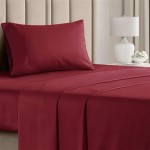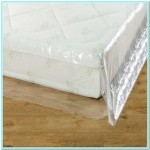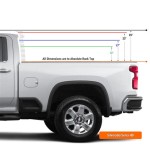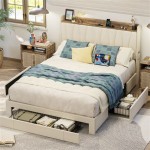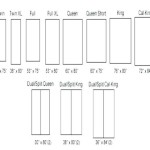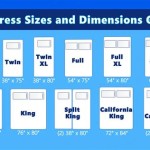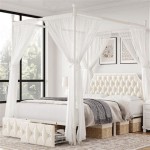How To Tell What Bed Size You Have
Determining the size of a bed is crucial for various reasons, including purchasing properly fitting bedding, replacing a mattress, or planning room layouts. Knowing the exact dimensions of a bed ensures that sheets, comforters, and bed frames are appropriately sized, preventing discomfort and aesthetic inconsistencies. This article provides a comprehensive guide to accurately identifying a bed's size through various methods.
The process of identifying a bed size involves measuring the mattress, comparing the dimensions to standard bed sizes, and considering the origin of the bed. Each element offers valuable insights into the bed's classification. Careful attention to detail and a systematic approach will lead to an accurate determination of the bed size.
Measuring the Mattress
The first and most direct method for determining bed size involves accurately measuring the mattress itself. This approach requires a tape measure and a clear understanding of the mattress's length and width. Accurate measurements are paramount for successful identification.
Begin by removing all bedding, including sheets, blankets, and mattress protectors. This ensures that the tape measure rests directly against the mattress surface. Stretch the tape measure horizontally across the mattress to determine the width. Record this measurement in inches. It is advantageous to take multiple measurements at different points along the width of the mattress, as slight variations can occur. The narrowest measurement should be used to avoid overestimation.
Next, measure the length of the mattress. Extend the tape measure from the head of the mattress to the foot. Record this measurement in inches as well. Similar to measuring the width, taking multiple measurements along the length is recommended to account for potential inconsistencies. Again, use the shortest measurement obtained.
Once the length and width are recorded, compare these measurements to standard bed sizes. These standard sizes provide a framework within which to categorize the mattress. Minor variations are possible, but the measurements should closely align with one of the established sizes.
Comparing Measurements to Standard Bed Sizes
Standard bed sizes have defined dimensions that serve as benchmarks for classification. Understanding these dimensions is essential for comparing measured values and accurately identifying the bed size. These standards are widely recognized within the bedding industry and across various geographical regions, although slight regional variations can exist.
The most common bed sizes in the United States include:
- Twin: Typically measures approximately 38 inches wide by 75 inches long. This is the smallest standard bed size, commonly used for children's rooms or single sleepers.
- Twin XL: Measures around 38 inches wide by 80 inches long. The added length makes it suitable for taller individuals and is frequently found in college dormitories.
- Full (Double): Measures approximately 54 inches wide by 75 inches long. This size provides more sleeping space than a twin and is suitable for single adults or teenagers.
- Queen: Measures approximately 60 inches wide by 80 inches long. The queen size is a popular choice for couples or individuals who desire more space to stretch out.
- King: Measures approximately 76 inches wide by 80 inches long. This size offers ample sleeping space for couples, providing individual comfort and minimizing sleep disturbance.
- California King: Measures approximately 72 inches wide by 84 inches long. The California King is longer and slightly narrower than the standard king, catering to taller individuals.
When comparing the measured dimensions to these standard sizes, it is important to note that slight variations are possible. For example, a mattress marketed as a queen might measure slightly less or more than the exact 60 inches by 80 inches. A measurement within an inch or two of the standard dimension is generally considered to fall within that size category.
If the measurements do not closely align with any of the standard sizes, the mattress may be a non-standard or custom size. In such cases, it is important to accurately record the measurements for future reference when purchasing bedding or accessories.
Considering the Bed's Origin and Markings
Another approach to identifying a bed size involves examining the bed frame and mattress for markings, labels, or other identifying information. The origin of the bed can also provide valuable clues about its size. Manufacturers often include labels or stamps indicating the bed size, making the identification process easier.
Carefully inspect the bed frame for any labels, stickers, or embossed markings. These markings may be located on the headboard, footboard, side rails, or underneath the frame. Look for phrases such as "Twin," "Full," "Queen," "King," or "Cal King," which directly indicate the bed size. In some cases, the labels may include the dimensions of the bed in inches or centimeters.
Similarly, examine the mattress for tags or labels. Mattress manufacturers are required to include labels that provide information about the mattress, including its size. These labels are typically sewn onto the mattress and may be located near the head or foot of the bed. Look for the same size designations mentioned above, as well as dimensional information.
If the bed was purchased from a specific retailer or manufacturer, their records can be consulted to determine the bed size. Reviewing purchase receipts, online order histories, or contacting the retailer's customer service department can provide confirmation. Providing the date of purchase and any identifying information about the bed helps the retailer or manufacturer locate the relevant records.
In cases where the bed is antique or of unknown origin, identifying the size can be more challenging. However, even without labels or purchase records, the style and construction of the bed can offer clues. Antique beds often adhere to different sizing standards than modern beds, so it is important to be aware of potential discrepancies.
For example, a four-poster bed with intricately carved details may be an antique full-size bed, which might have slightly different dimensions than a modern full-size bed. Similarly, a metal-frame bed with a simple design may be a vintage twin or twin XL bed. Consulting with antique furniture experts or appraisers can provide further insights into the origin and size of antique beds.
Understanding the origin of the bed and examining it for markings can supplement the measurement method, providing a more comprehensive approach to identifying the bed size. This is especially useful when dealing with older or less common bed sizes.
Accurately determining the bed size is integral to a variety of practical applications, spanning from the acquisition of bedding to the planning of interior spaces. The methodology outlined above provides a robust framework for identifying bed sizes, irrespective of their age or markings. By meticulously measuring the mattress, comparing those measurements to established standards, and considering the bed’s origin and any identifying marks, individuals can ascertain the correct bed size to suit their needs.
When measuring, it is essential to maintain accuracy and precision. The use of a high-quality tape measure and meticulous attention to detail minimizes the risk of error. Confirming measurements by taking multiple readings across various points along the mattress's length and width further enhances the reliability of the process. This approach ensures that the identified bed size aligns with industry standards, facilitating the selection of appropriately sized bedding and bed frames.
The comparison of measurements to standard bed sizes serves as a foundational step in the identification process. Familiarity with the dimensions of common bed sizes—Twin, Twin XL, Full, Queen, King, and California King—allows for a direct comparison with the measured values. Although minor variations may exist due to manufacturing tolerances or design variations, a close alignment with these standards typically suffices for categorization. Variations, especially when significant, indicate a potential custom or non-standard size, necessitating a careful recording of exact dimensions for future reference.
Moreover, the examination of the bed's origin and visual indicators, such as labels, markings, or style characteristics, complements the measurement-based approach. Manufacturers’ labels and purchase records often provide conclusive evidence of the bed size. However, in cases where such documentation is absent, the bed's style and construction can offer valuable clues, particularly for antique or vintage beds. Consulting with experts or appraisers can prove beneficial in accurately determining the size and origin of such unique items.
The accurate identification of bed size has implications beyond mere convenience. It directly impacts comfort, aesthetics, and the functional use of space. Properly sized bedding ensures a comfortable sleeping environment, while correctly matched bed frames enhance the visual appeal and structural integrity of the bed. Furthermore, knowing the bed size is essential for effective room planning, enabling individuals to optimize the layout and flow of their living spaces.
Therefore, the outlined methods provide a comprehensive and reliable means of identifying bed sizes, catering to a wide range of scenarios and bed types. By integrating measurement techniques, comparative evaluations, and observational analysis, individuals can confidently ascertain the correct bed size, thereby optimizing their purchasing decisions and enhancing the overall functionality and aesthetics of their sleeping environments.

How To Measure Bed Size 10 Steps With Pictures Wikihow

Bed Sizes Guide Curtain Of Maine

Mattress Sizes What Size Room You Should Have Them In The Sleep Judge
Uk Bed And Mattress Size Guide Sizing Aspire

The Ultimate Guide To Adult Bed Sizes What Katy Said

Crib Mattress Size Vs Twin

Understanding Mattress Sizes And Dimensions

Mattress Sizes All You Need To Know Origin Sleep Malaysia

Duvet Size Guide Everything You Need To Know Sleep Journal

Q A How To Quickly Choose The Best Mattress Size For You Ez Living Furniture

